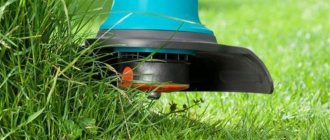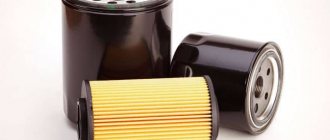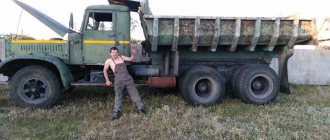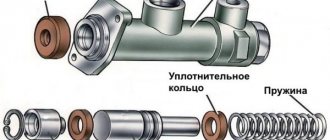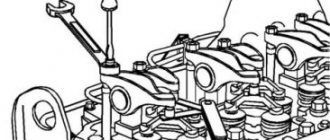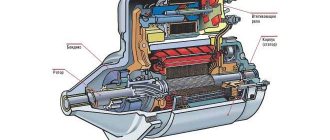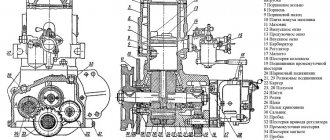The reliability and survivability of gasoline wheeled lawn mowers depends not only on the quality of their manufacture, but also on proper timely maintenance, without which they will quickly fail.
However, for the correct maintenance of the mower, it is necessary not only to carefully read the instruction manual, but also to familiarize yourself with how it works, and also at least in general terms to understand the principles of operation of all parts of the device.
How to start the device?
How to start the engine correctly is written in detail in the operating instructions for the selected model of lawn mower, so starting the engine is not difficult for a fully serviceable machine .
If following all the recommendations did not lead to starting, then either the motor or some additional equipment is faulty or incorrectly configured, so the mower needs service or repair.
For more information on mower malfunctions, as well as how to repair them, you will find in this article (Gasoline Lawn Mower Malfunctions).
If there is no instruction manual for the device, then you need to proceed as described below.
First you need to carefully inspect the mower to find all the controls related to the engine, that is :
- button or toggle switch on / off;
- manual starter handle;
- electric starter button;
- accelerator handle;
- fuel pump button;
- throttle control lever.
On inexpensive models of lawn mowers, costing less than twenty-five thousand rubles, most often there are almost all of these elements with the exception of the electric starter button, but there are models without most of these elements or with an electric starter button.
On the most expensive models, there is usually only a toggle switch for turning the engine on and off, as well as a manual starter handle, all other elements work in automatic mode and do not require operator intervention.
Then perform the following sequence of actions (if there are no elements, then they work in automatic mode or you could not find them):
- check the oil level and the presence of gasoline;
- turn on the toggle switch for turning the engine on and off;
- pump up fuel using the corresponding button;
- move the throttle control lever to the start mode or the “Off” position;
- tighten the manual starter cable until noticeable resistance appears;
- smoothly, but strongly and quickly pull the manual starter cable towards you;
- if the engine does not start, then repeat the last 2 operations 2-3 times;
- if the engine still does not start, then you must either find the missing controls or diagnose it in order to detect and fix the problem.
The only difference between starting devices with an electric starter is that instead of using a manual starter cable, they press the electric starter button and hold it down for 1-2 seconds.
Robotic Lawn Mowers
High tech and smart device. Equipped with an electric motor, runs on batteries. The robot mower independently, without human intervention, moves around the site, and returns to the docking station for recharging. Equipped with slope and rain sensors. The device is similar in technology to a robot vacuum cleaner. Professional models are controlled by a person using a remote control from a considerable distance (up to 800 m). There are disc, rotary and special chassis (on tracks). Household robotic mowers are designed for processing lawns, lawns, etc. Professionals mow football stadiums, mow grass along roads and railways, work in ravines and reclamation canals, and also destroy hogweed thickets - even the dust of this plant causes burns in humans.
agrox.by
RUB 2,500.00
All stores (2)
Husqvarna Automower 105 Robotic Lawnmower
from RUB 2,500.00
Robotic lawnmower, cutting width 15 cm, body: plastic.
Description Where to buy (2)
How to use?
The main purpose of lawn mowers is to mow young low grass on lawns and relatively flat clearings, but sometimes you have to mow tall grass or weeds, as well as mow lawns on slopes.
Even when mowing young grass, the correct sequence of actions must be followed, this will extend the life of the mower parts and reduce the physical burden on the operator.
All actions performed during mowing can be divided into:
- preparation for mowing;
- choice of operating mode;
- rectilinear movement;
- turns;
- stop;
- emptying the grass collector;
- end of work;
- lawnmower maintenance.
Preparing for mowing
This operation is especially important after a long break or when the lawnmower has been operated in heavy duty for a long time.
Mowing preparation includes:
- visual inspection of the mower for visible defects, including loose bolts or nuts;
- checking the oil level in the engine with subsequent topping up or replacing;
- checking the condition of the belt, gearbox and knife, followed by maintenance, that is, replacement, repair, sharpening or lubrication, if necessary;
- checking the condition of all controls and their lubrication / maintenance if necessary;
- checking the level of gasoline, as well as topping it up, if necessary;
- adjustment of the folding handle for the height of the operator.
All these procedures are described in detail in the instruction manual, so you must read this document carefully, and always keep it at hand in case of any emergency situations.
In addition, on mowers, the wheels of which are bolted to the frame, it is necessary to make sure that the wheels are securely fixed , as well as their free rotation, and, if necessary, fix them or lubricate them.
Operating mode selection
After preparation for mowing and delivery of the lawn mower to the place of work, it is necessary to select the appropriate mode, that is, adjust the mowing height and activate the method of processing and ejection of the mowed grass that is necessary in this situation.
On most models, the mowing height is centrally adjusted , so it is enough to move the corresponding lever to the desired position, however, on parts of the mowers, the adjustment is carried out on each wheel individually.
This increases the time spent on the procedure, but allows you to set the knife at a certain angle, which is useful when working in areas with difficult terrain.
The choice of each of the methods for processing and ejecting the cut grass is described in detail in the instruction manual, so you need to carefully read this document , because the choice of one or another method depends on the design of the mower and is not always applicable even to machines from the same manufacturer.
Rectilinear motion
The rectilinear movement of non-self-propelled vehicles does not cause any particular difficulties, because the operator pushes them at the most comfortable speed for him. With self-propelled mowers, the situation is different, since their speed depends on the speed of rotation of the engine crankshaft and the gear ratio of the transmission.
On mowers with one gear, the speed is controlled by changing the speed of rotation of the engine shaft, however, for high-quality grass mowing, the crankshaft speed should not decrease below 2.5–2.8 thousand per minute, which is only slightly less than the maximum rotation speed.
If the shaft turns more slowly, the blade will not be able to effectively and smoothly cut the grass . Therefore, on mowers with a CVT or multi-speed hydrostatic transmission, the gear necessary to obtain the optimal driving speed is first set, and only after that they begin to move forward.
On all self-propelled lawn mowers, the corresponding bracket on the folding handle is pressed to start moving forward.
turns
The mower cannot turn on its own, so the turn always occurs due to the physical impact of the operator.
In areas with low grass and a large (5 meters or more) turning radius, it is enough to turn the handle a little in the opposite direction at each step .
However, in areas with high grass or if you need to turn (turn around) in a small space, you must first press the handle to raise the front wheels and only then turn the device to the desired angle.
If you do not raise the front wheels, you will have to strain very hard, because they create a noticeable resistance to lateral movement.
In addition, on self-propelled mowers, before starting the maneuver, the drive bracket must be released so that the drive wheels are not connected to the engine during the turn. If you do not do this and turn while driving, then the load on the transmission will increase sharply and its resource will be reduced.
Stop
If it is necessary to stop for a short time (for a few seconds, for example, to wipe sweat from the forehead), then it is enough to stop pushing the non-self-propelled vehicle forward or to release the corresponding bracket of the self-propelled vehicle.
However, if the stop is for 20 seconds or more, then you need to release the knife connection bracket and use the accelerator to reduce the engine shaft speed to idle (900–1300 rpm, depending on the engine features).
This will reduce fuel consumption and increase engine life. If the stop is for a minute or more, then it is also advisable to turn off the engine so that it does not waste its resource in vain.
Emptying the grass box
Some models of mowers are equipped with a grass collector, that is, a container in which all the cut and chopped grass is collected.
Most grass catchers have a full indicator - a small window covered with transparent glass, through which you can see how full it is.
When the grass catcher is full but not empty, mowing efficiency drops sharply, because the cut grass clogs the deck , which is why it no longer forms an upward air flow that lifts the blades of grass from the ground.
Further mowing without emptying the grass collector leads to a sharp increase in the load on the engine and a decrease in its resource.
To empty the grass catcher, the mower is stopped and the knife drive is turned off (if provided by the design), and the engine speed is reduced or it is turned off (depending on the distance to the place where the cut grass is stored).
Then the latches are turned off and the grass catcher is disconnected from the mower body (this event is described in detail in the operating instructions for the device), after which the container is emptied and installed on the lawn mower, performing all these steps in reverse order.
End of work
Having finished mowing the grass, the mower is delivered to the cleaning site, where, after turning off the engine, a hose is attached to the deck and water is supplied to wash all the cut grass out of it. For this, the pressure generated by ordinary household submersible pumps of the "Rucheyok" type is sufficient.
Then, when the engine cools down, the body is washed with a jet of water from the outside . If it is not possible to wait until the motor cools down, then outside you can cover the device with a soft broom or blow it with air flow using (a blower) or a vacuum cleaner for this.
Mower Maintenance
After finishing mowing and cleaning the device from grass residues, the lawn mower must be serviced, that is, check :
- the condition of the knives;
- fastening and ease of rotation of the wheels;
- tightening of all bolted connections;
- softness of the course of all control knobs;
- the state of the paintwork (LKP) of the body.
If any defect is found, then it is necessary either to immediately eliminate it, or to write down a list of faults somewhere in order to repair the device in your free time and have time to do it before the start of a new mowing.
If defects are found on the paintwork of the case (most often these are various scratches), then it is advisable to immediately either paint over them with paint compatible with the paintwork, or treat them with silicone spray , which will protect the paint and metal from further destruction.
Beautiful lawn in the garden
Which mower to choose? It is best to choose a mower depending on the size of the lawn. To control a small lawn, a manual drum mower is enough. An electric mower will be better for a larger area. However, here the limitation will be the length of the electrical wire and the distance from the outlet, as well as the number of plants on the site (it is difficult to meander between them, and the cable extends behind). In these conditions, the lawnmower will work, best for large self-powered lawns. The company's offer also includes battery-powered self-propelled lawn mowers that move chaotically across the lawn, cutting millimeter-sized pieces of straw that do not need to be raked. The problem of swathing, which is not known what to do, will also be solved by a mower with a mulching function, that is, mowing the straws and spreading them over the surface of the lawn (however, it often has to be mowed). When buying a mower, you should pay attention to its working width - the more lush the lawn, the larger it should be. In hard-to-reach places - around trees, on slopes and in places where grass cuts less often - shrubs are reliable.
How to wash a gas lawn mower?
For washing, the lawn mower is delivered to the site, where not only there is access to water under low pressure (0.5–3 bar), but also water drainage with the remains of mowed grass is provided. The hose is connected to the fitting on the deck and water is supplied, after which it independently flushes out all the remnants of the grass and cleans the deck from the inside.
If the mower is not equipped with such a fitting, then it must be tilted to one side at an angle of 50–60 degrees and fixed in this position, after which the deck should be thoroughly cleaned with a jet of water.
After each mowing, it is necessary to wash not only the body, but also the engine cooling fins , for which a sprayer is used to avoid strong water pressure, because water coming under high pressure and with one jet can penetrate the ignition system.
Therefore, it is better not to wash the engine of a mower with electronic ignition , but to clean it with a stream of air and sticks made of soft plastic or wood.
After each washing or purging, carefully inspect the exhaust pipe and the air filter intake port. If there are remnants of grass in them, then they are carefully removed.
Can you mow wet grass?
Despite the fact that mowing wet grass does not pose a direct threat to the parts of the machine, it is undesirable to mow it , because wet grass is noticeably heavier, which means that the air flow created by the knife will not be able to lift it as effectively as dry vegetation.
If it is necessary to urgently mow the wet grass, without waiting for it to dry, then this must be done in several passes , gradually reducing the cutting height as much as possible, which will increase the mowing time, but will provide much higher quality.
Storage
Store lawnmowers in dry, well-ventilated areas. For short-term storage, no preparatory actions are required, it is enough to roll the device into the place intended for it and fold the handle.
If the storage period exceeds a couple of months, then the device must be prepared, for which the following steps are performed :
- drain gasoline and oil;
- dry the body;
- preserve rods and bearings;
- check and, if necessary, sharpen the knife.
Draining gasoline and oil
This operation is necessary for two reasons:
- Fuels and lubricants lose some of their characteristics during long-term storage, so starting the engine after a long idle period with gasoline or oil remaining after the end of use in the current year can cause serious damage to the engine and reduce its resource.
- If the machine has to be turned upside down or placed upright during storage, fuels and lubricants may leak out, after which they will stain the floor and body of the mower, fill the room with a heavy oily smell and create a fire hazard.
The method for draining these liquids depends on the design of the mower and is detailed in the owner's manual.
If there is no manual, then the mower must be put on the table (fuel and lubricants are drained in this way only after the engine has cooled), tilted to one side at an angle of 45 degrees and carefully inspect the motor and fuel tank from below in search of drain holes .
If they are not there, then you must first unscrew the fuel tank cap and turn the mower upside down so that the gasoline stacks, then tighten the fuel tank cap.
Before draining the oil, it is necessary, without turning on the ignition, to pull the manual starter 5–10 times, thanks to which the oil pump will supply lubricant to all rubbing engine parts, as a result, they will be protected from moisture until spring. Then you need to unscrew the oil filler cap and turn the device over again, waiting for the liquid to drain completely, and then return the cap to its place.
Some models of mowers are equipped with engines , which manufacturers claim that the motors do not need to change the oil, but only top it up. This is not a very honest statement, because the engine can run on old oil, which is constantly topped up with new, but only for a limited time, for example, 500 or 1000 hours.
This engine resource is just enough for the entire warranty period declared by the manufacturer (usually 2–5 years), after which the engine is likely to break down, while when changing the oil, the engine can operate for 10–20 years without repair.
Therefore, before winter, drain the oil in mowers with such a motor or not drain, everyone will have to decide individually.
If high-quality oil is poured into the engine that corresponds to it according to SAE and other parameters, then you can not only drain the old oil, but also fill in new one, however, this procedure must be carried out on a hot engine , so it is applicable only where there is a special hole for this.
Then, the oil filter is washed in diesel fuel or gasoline (if it is installed on the model and can be washed) and new oil is poured, after which, without turning on the ignition, the manual starter cable is pulled 5–10 times to lubricate all rubbing engine parts with new oil.
Hull drying
Proper maintenance means washing the case after each use, which is why it is likely that water droplets left on the case will freeze in winter and damage the paintwork or rubbing parts .
Therefore, before leaving the mower for long-term (winter) storage, it is necessary to carefully blow the body from all sides with a blower, paying special attention to the junction of the wheel axles and bushings that act as a bearing.
If the wheel axles are mounted on bearings, then it is necessary to carefully blow the bearings from all available directions in order to remove even the smallest particles of moisture from them.
Preservation of rods and bearings
It is necessary to treat the inner surface of all cable drives (rods) with WD-40 liquid to remove water from them, and then pour 0.2–0.5 cm3 of engine oil into them using a syringe.
If this is not done, then after 3-5 years there is a high probability that the cables will begin to stick, which will lead to the inability to slow down the engine speed and other problems.
In some models of mowers, bearings are lubricated, including sliding ones (shaft-sleeve) through special grease fittings. Before winter, such bearings must be filled with grease recommended by the manufacturer , using a syringe for servicing (syringing) the running gear of old cars.
Checking and sharpening a knife
The sharper the knife, the lower the load on the engine, which means the longer its service life. The most important condition when sharpening a knife is to maintain balance, because if one side is even half a gram heavier than the other, this will lead to strong beats that negatively affect the life of the crankshaft bearings.
To check the centering, the removed knife can be placed on a plate 1-2 mm thick vertically fixed in a vice, if the balance is maintained, then the balance will be achieved when the plate is exactly in the middle of the knife.
If it is shifted to the side, then when sharpening, more metal is removed from this side, constantly checking the balance. also give the knife for sharpening to a specialized workshop , engaged in the repair and maintenance of gasoline lawn mowers, or install a new one instead.
In any case, before installing a sharpened or new knife, it is advisable to check its balance, because it is many times easier and cheaper than changing bearings and an engine crankshaft broken due to an unbalanced knife.
Safety precautions when working with a gasoline mower
Each manufacturer in the instruction manual of his lawn mower describes in detail how to turn it on, what can and cannot be done with this device in order to avoid injury or damage.
The basic safety rules for working with lawn mowers are the same as for other motorized garden equipment, i.e.:
- You can not neglect the daily inspection and timely maintenance, because this will lead to a decrease in the resource of parts and assemblies of the lawn mower.
- Do not service the machine or mow the grass after taking alcohol, drugs and any substances that affect the speed of reaction, balance and adequacy.
- Children must not be allowed to operate the mower without adult supervision.
- It is undesirable to use the device for mowing grass, the height of which is more than 5 times the maximum mowing height, for such vegetation it is necessary to take either a special lawn mower or use a trimmer.
- It is undesirable to use the lawn mower in cluttered areas due to the high probability of the knife hitting a hard obstacle.
- Do not turn over or tilt the mower until the blades come to a complete stop.
- Do not smoke or use open flames while servicing or refueling the machine.
Grass in the yard: how to choose a lawn mower?
In favor of the trimmer
Trimmers are not for the weak.
After all, the user will have to wear a 5-7-kilogram device attached to the belts, or hold in his hands (and actively wield) a 3-kilogram device. Trimmers have an obvious advantage over wheeled lawn mowers: they can mow grass of any height - even to the waist, while wheeled lawn mowers are more suitable for regular maintenance of the site: if the grass has outgrown a certain height, then the "cart" can not cope. In addition, the trimmer is always maneuverability and the ability to carefully avoid obstacles: bushes, trees, flowers, garden decor. The trimmer - if power allows - cuts off the young growth of shrubs and weeds, and besides, he does not need to adapt to difficult terrain.
Cons of portable trimmers
The main disadvantage is the weight and vibration, which is not completely extinguished even with anti-vibration systems. Hence the load on the back and on the arms.
In addition, cut grass remains in place, and after "cutting" it must be removed with a rake or other garden tool.
Finally, with a trimmer, you cannot adjust the cutting height.
What to look for when choosing a portable trimmer?
The most important characteristic is power. The higher it is, the better and faster the trimmer mows, but at the same time there will be more noise and vibration. The power of electric trimmers varies from 250W to 1700W.
Power up to 600-700 W is suitable for the care of small unopened areas, trimming the edges. Such devices are often used in addition to a more powerful trimmer or wheeled lawn mower. 1000-1200 watts is some serious power for an electric trimmer. Well, 1500-1700 W is already so uneconomical that it is more profitable and more reliable to buy a gasoline trimmer. The power of models running on gasoline (from 1 to 7 hp) is usually enough to care for complex and neglected areas, but here the increased power of four-stroke engines is needed not only for mowing directly, but also for moving the unit.
Another important parameter is what the cutting block consists of. It can be only a fishing line or a fishing line and a knife (disk), and rarely only a knife. The fishing line is a consumable item, it can suddenly end, and then having a knife will help out a lot. The knife can become dull or shy - then the fishing line. Although every user with experience understands what is suitable for what: someone cuts bushes with a knife, someone likes thick fishing line more, and uses the knife for trimming. In most cases (especially in inexpensive trimmers), a thin fishing line of poor quality is included in the kit - even for trimmers of famous brands. Experienced users immediately change the fishing line to a thicker one - 1.6-2 mm in diameter.
